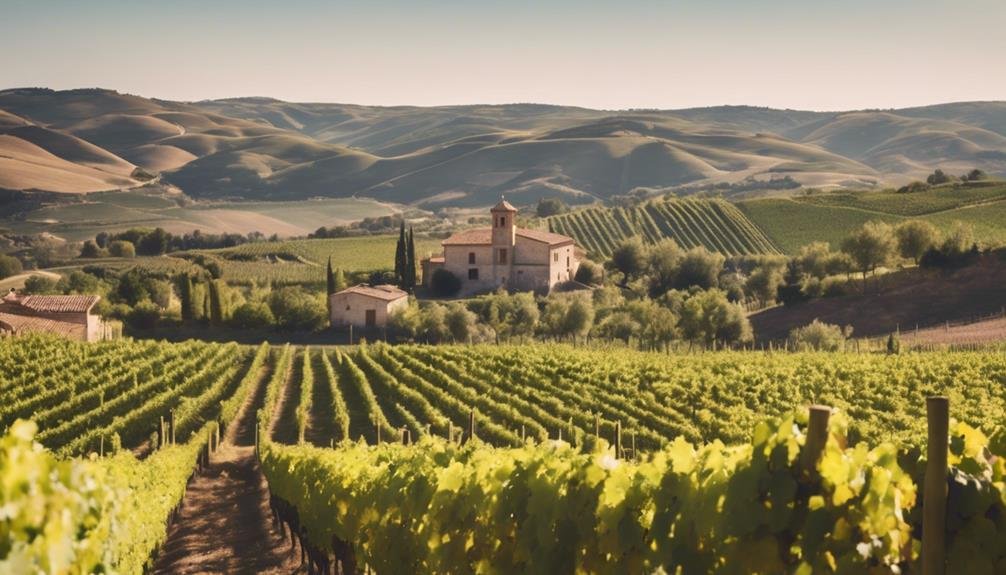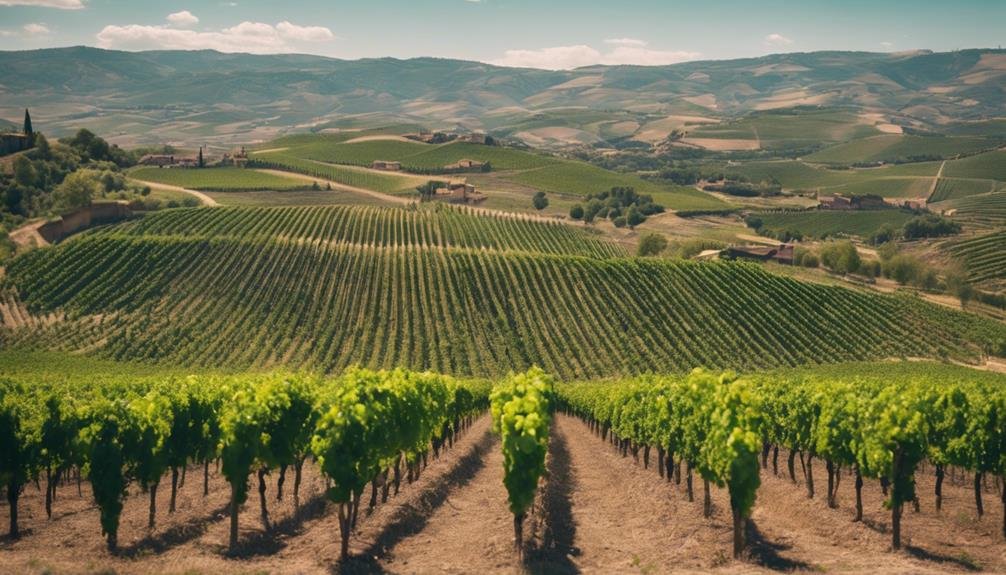Discover the world of Rioja wines through their diverse flavors, shaped by oak aging, from zippy fruits to complex notes, packed with high tannins. Classified as Rioja, Crianza, Reserva, and Gran Reserva, each style offers distinct characteristics based on aging criteria. Explore Rioja's regions – Oriental for fruit-forward wines, Alta for higher tannins, and Alavesa for acidity – set against picturesque landscapes. Pair these wines with baked pasta, roasted pork, or chorizo, and benefit from Madeline Puckette's insights on varietal understanding and engaging wine tasting parties. Delve into the rich tapestry of Rioja wines, a connoisseur's delight.
Flavor Profile of Rioja Wines
Rioja wines exhibit a diverse range of flavors that are influenced by the production and aging process, offering a unique tasting experience for enthusiasts.
The oak influence plays a significant role in shaping the flavor profile of Rioja wines. Younger wines showcase zippy fruit flavors, while longer-aged wines develop more complex characteristics, picking up distinct oak notes.
The aging process is essential in determining the final taste, with flavors evolving over time to create a balanced and harmonious wine.
The interplay between oak influence and aging duration results in Rioja wines with high tannins and a big flavor profile that represents the characteristics of the Tempranillo grape varietal.
This combination makes Rioja wines ideal for hosting wine tasting parties, allowing guests to explore the nuances of this renowned wine region.
Rioja Wine Classification Overview
Within the regulatory framework of the Consejo Regulador DOCa Rioja, the classification of Rioja wines encompasses four main styles, each offering distinct characteristics and aging requirements.
The aging process plays an essential role in defining these styles. Rioja wines are classified as Rioja, Crianza, Reserva, and Gran Reserva.
Crianza wines undergo a minimum aging process of two years, with at least one year in oak barrels. Reserva wines are aged for a longer period, providing a more serious taste profile, with better grapes selected for production.
Gran Reserva wines have the most extended aging period, resulting in complex wine characteristics, rich in flavor and texture. Understanding these classifications helps wine enthusiasts appreciate the diverse range of Rioja wines available.
Exploring the Rioja Wine Region

Nestled in North Central Spain and framed by the Sierra Cantabria mountain range, the Rioja wine region boasts a diverse landscape that influences the unique characteristics of its wines. The region is divided into Rioja Oriental, Rioja Alta, and Rioja Alavesa, each offering distinct styles.
Rioja Oriental features fruit-forward, rounder wines, while Rioja Alta and Alavesa produce wines with higher tannins and acidity, known for their elegance. Visitors to Rioja can explore scenic vineyards and immerse themselves in the region's rich cultural heritage.
The combination of varied terroirs, from the Ebro River valley to the mountain foothills, contributes to the complexity of Rioja wines. This region not only offers exceptional wines but also a captivating experience for wine enthusiasts seeking both beauty and tradition.
Perfect Food Pairings for Rioja Wine
Enhancing the dining experience with well-matched flavors, the ideal food pairings for Rioja wine elevate both the dish and the drink. For Rioja Alta and Alavesa wines, consider baked pasta, tomato-based dishes, roasted pork, chorizo, lamb, and paella. These wines shine with rich, flavorful options.
On the other hand, Rioja Oriental wines complement spicier foods and richer dishes, offering a unique experience. Older Rioja wines harmonize beautifully with a board of hard cheeses, showcasing their versatility.
Whether enjoying a spicy pairing or indulging in a rich dish, Rioja wines provide a diverse range of pairing options based on the region and style. Experimenting with different combinations can enhance the enjoyment of both the wine and the meal.
Insights From Madeline Puckette

Madeline Puckette, a distinguished James Beard Award-winning author and Wine Communicator of the Year, offers valuable insights into the world of wine, particularly shedding light on Rioja wines and their characteristics. Through her expertise in wine education, Puckette provides essential knowledge on tasting techniques for appreciating Rioja wines:
- Understanding the significance of grape varietal characteristics in Rioja wines.
- Exploring the diverse flavors and profiles of Rioja wines based on aging and production methods.
- Learning how to host engaging wine tasting parties to experience the full spectrum of Rioja styles and classifications.
Puckette's contributions to wine education and her passion for sharing knowledge make her an invaluable resource for wine enthusiasts seeking to enhance their understanding of Rioja wines.
Frequently Asked Questions
Can Rioja Wines Be Aged Too Long, Affecting Their Taste?
Wine storage and aging are critical factors in maintaining flavor profiles. Cellar management is key to preventing oxidation. Extended aging can impact Rioja wines, altering taste characteristics. Understanding ideal aging periods is essential for preserving the wine's quality.
Are There Any Vegan-Friendly Rioja Wine Options Available?
Discover the treasure trove of vegan-friendly Rioja wines, showcasing a symphony of flavors that harmonize with plant-based delights. Delight in organic-certified options that marry ethical principles with the rich tapestry of Rioja's winemaking heritage.
How Does the Altitude of Rioja Vineyards Impact the Wine?
Altitude influences Rioja vineyards by affecting temperature, sunlight exposure, and grape ripening. Higher altitudes typically lead to cooler climates, which can result in slower grape maturation, higher acidity, and enhanced aging potential, contributing to the wine's complexity and structure.
Can Rioja Wines Be Enjoyed With Seafood Dishes?
Rioja wines can be enjoyed with seafood dishes, especially when opting for lighter styles like Rioja Oriental. The fruit-forward and lush characteristics of these wines complement seafood's delicate flavors. Pair with grilled fish, seafood paella, or shrimp tapas for a delightful culinary experience.
Are There Any Sustainable or Organic Rioja Wine Producers?
Several Rioja wine producers implement organic practices to reduce their environmental impact. By prioritizing sustainability, these wineries focus on creating high-quality wines while preserving the ecosystem. Seek out these environmentally conscious producers for a unique tasting experience.
Conclusion
In a world where bold flavors and rich history intertwine, Rioja wine stands as a proof to the artistry and tradition of winemaking. From its diverse flavor profile to its intricate classification system, Rioja offers a unique experience for wine enthusiasts.
The region's geographical significance and ideal food pairings further enhance the cultural significance of Rioja wine. Through exploration and appreciation, one can truly uncover the essence of Rioja and its enduring legacy in the world of oenology.
